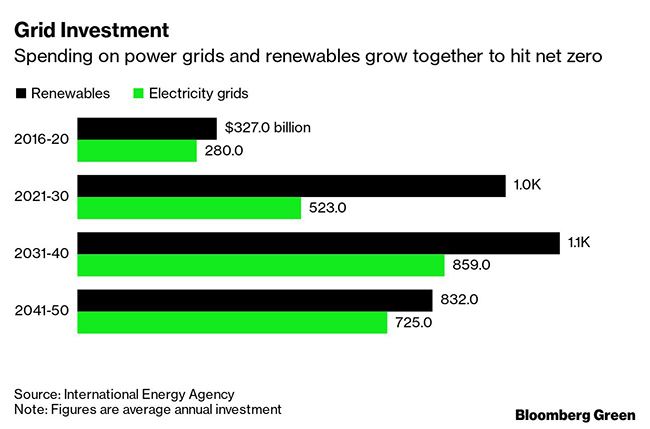|

By Will Mathis
and Akshat RathiIf
-
World spending on cables will have to rival solar and
wind power
If you
assessed the future of energy based on how it’s depicted in images —
rows of solar panels, fields with wind turbines, big blocks of
batteries — you could be forgiven for forgetting about all the
cables.
But it
would be a big omission, because cables are the backbone of the
electric grid. In many
cases, building a grid that can take on all those renewables can be
more expensive than the cost of the solar and wind farms themselves.
Consider
the UK. Bound by a climate law that calls for reaching net-zero
emissions by 2050, the country is on a spree to build as much 50 GW of
offshore wind power by 2030. That would more than triple current
capacity at a cost of about £120 billion ($139 billion).
In July,
the country’s grid put out a plan to spend
£54 billion to ensure that all offshore wind capacity can
actually be used. Half the money would go toward building
infrastructure to link up turbines that are hundreds of miles out at
sea, with the rest to ensure that the new power supply reaches the
people who need it. In other words: cables.
“No one
really talks about the grid. It’s a little bit boring to most people.
They don't understand it or get it,” says Keith Anderson, chief
executive officer of Scottish Power, a division of renewable power
giant Iberdrola SA. “You want net zero? You need the grid. You want
offshore wind? You need the grid. You want electric cars? You need the
grid.”
The UK
isn’t alone. China’s State Grid Corp. aims to spend
$350 billion through 2025 on upgrades to increase the
transmission of renewable power. The US will need
to spend $200 billion on cables to meet 2030 climate goals,
while it spends about $360 billion on clean-power generation. Overall,
the International Energy Agency says global investment in power grids
would need to hit
$820 billion per year by 2030, up from about $260 billion
in 2020, to get on track to limit global warming to 1.5° Celsius.

These
spending plans represent a shift in energy-transition strategy from
relying predominantly on renewable sources of power. For the most
part, new solar farms and wind parks have just been added to the
existing grid, but scaling up these technologies to the level needed
to prevent the worst impacts of climate change will require a network
built to maximize renewable-energy deployment. And while it’s true
that, at the point of generation, solar and wind power are already
vastly cheaper than fossil fuels, projections about their increasing
affordability often fail to include the anticipated cost of grid
infrastructure.
“Grid
buildout is an essential tool to facilitate decarbonization,” said
Will Gorman, researcher at Lawrence Berkeley National Laboratory.
“Transmission is going to be a key piece of the puzzle when talking
about high penetration of renewables on the grid.”
Calling all
podcast lovers. Yes to a world with zero emissions… but how do we get
there? On Zero, a new podcast from Bloomberg Green, we’re introducing
listeners to the people making that world possible — from scientists
building physics-defying batteries to politicians passing successful
climate laws. Subscribe
now on Spotify and Apple to
get the first episode in September.
To see that
dynamic at work, you can look to Texas, which developed what are known
as “competitive renewable energy zones” to build out transmission that
would connect some of the state’s best wind resources to population
centers that needed it. As a result, Texas has become one of the
world’s biggest sources of wind power globally. If it were a country,
the state would have the fifth largest fleet of wind farms in the
world.
At the same
time, Texas is an example of grids’ limits. The state has no links to
power networks in other states, meaning it can’t export electricity
when generation exceeds demand, or import from other places that have
different wind and solar resources.
That
shortfall also highlights one of the biggest impediments to grid
expansion: the priorities of local politicians and communities.
Leaders in Texas don’t want to join up with other grids because of the
federal oversight that would come as a side effect.
The UK is
facing a different kind of local opposition. Coastal populations are
happy with wind turbines far out at sea, but don’t want the cable
infrastructure required to bring the power to shore near them. That
means taking a longer route to land the cables where there aren’t
people.
One of the
surest ways to cut emissions, energy use and energy bills is to
electrify as much of our economy as possible, while cleaning up the
grid. All that, however, depends critically on no longer ignoring the
grid itself.
Calling all filmmakers. Bloomberg
Green Docs is still accepting submissions. We want to see
your short documentaries on climate change. Submit your film by
September 16 and compete to win a $25,000 grand prize, plus the
opportunity to showcase your work at a special screening in Los
Angeles on October 26.
Like
getting the Green Daily? Subscribe
to Bloomberg.com for unlimited
access to breaking news on climate and energy, data-driven
reporting and graphics and Bloomberg Green magazine. Read and share
this story on the web here.
Green Play Ammonia™, Yielder® NFuel Energy.
Spokane, Washington. 99212
www.exactrix.com
509 995 1879 cell, Pacific.
exactrix@exactrix.com
|